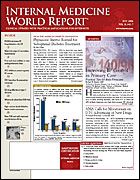Publication
Article
Internal Medicine World Report
Neuroprotectant Shows Promise after Ischemic Stroke
Author(s):
From the American Stroke Association
KISSIMMEE, Fla—An investigational neuroprotectant has been shown to significantly reduce disability when given within 6 hours of acute ischemic stroke, said Kennedy R. Lees, MD, professor of cerebrovascular medicine, Western Infirmary at the University of Glasgow, United Kingdom, at the American Stroke Association’s International Stroke Conference 2006.
N Engl J Med
The agent, NXY-059, improved disability scores on the modified Rankin scale at 90 days following stroke but had no effect on National Institutes of Health Stroke Scale (NIHSS) scores in the SAINT I (Stroke—Acute Ischemic NXY Treatment) study (. 2006; 354:588-600). The 2 outcome measures were coprimary end points, but the first in the hierarchy of end points was the overall distribution of disability scores on the modified Rankin scale, explained Dr Lees, lead investigator of SAINT I. NXY-059 is a free radical–trapping agent that has reduced infarct size and preserved brain function in animal models.
SAINT I included 1722 patients with acute ischemic stroke who were randomized to either placebo or NXY-059 within 6 hours of stroke onset as a 1-hour loading infusion, followed by maintenance infusion for 71 hours.
P
P
Compared with placebo, 3.7% more patients assigned to NXY-059 recovered their ability to walk ( = .02) and became less dependent on others for bodily needs, and 4.4% more made a complete recovery (= .003).
The drug did not demonstrate benefit for the prespecified neurologic end point on the NIHSS. But in a posthoc analysis of participants who scored ≤1 (indicative of excellent neurologic recovery), there was a trend toward improvement with NXY-059.
P
NXY-059 was beneficial irrespective of the time to treatment, stroke severity, or treatment with the tissue plasminogen activator (tPA) alteplase, said Dr Lees. When alteplase was added to NXY-059 or placebo, NXY-059 reduced the risk of symptomatic hemorrhagic transformation from 6.4% to 2.5% ( = .36) and the risk of asymptomatic hemorrhage from 20.9% to 12.9%.
According to Dr Lees, the benefit observed with NXY-059 amounted to an average improvement of 0.13 point on the modified Rankin scale per patient, “which suggests that 8 patients would need to be treated to achieve improvement equal to 1 point for 1 patient.”
The investigators used a change in Rankin scale scores to assess the effect of NXY-059, a departure from the traditional way the Rankin scale is employed in clinical trials of neuroprotectants, which uses a threshold score of ≤2 that indicates either no symptoms, no significant disability, or only slight disability.
Using a shift in Rankin scale, rather than a dichotomized analysis, may be a more accurate method of gaugingimprovement, argued other presenters. Said Jeffrey Saver, MD, medical director of the stroke center at the University of California, Los Angeles, “Stroke treatments are generally not curative but improve outcomes along a broad functional continuum….When we dichotomize outcomes, we’ve thrown out a lot of outcomes information, which means that we often underestimate our treatment benefit and/or our treatment harm.”
As an example, improvement from a Rankin scale score of 6 (dead) to 3 (moderately disabled) would not be counted as a clinically meaningful improvement using a dichotomized analysis, “and this goes against our biological intuition,” he said.
Returning to the investigational agent, Marc Fisher, MD, of the University of Massachusetts, Worcester, said, “There was a significant effect on reducing hemorrhagic risk with concomitant tPA use, which suggests that NXY-059 would be used routinely with tPA, especially in patients at high risk for intracerebral hemorrhage.”
NXY-059 will be further explored in the larger SAINT II trial.





